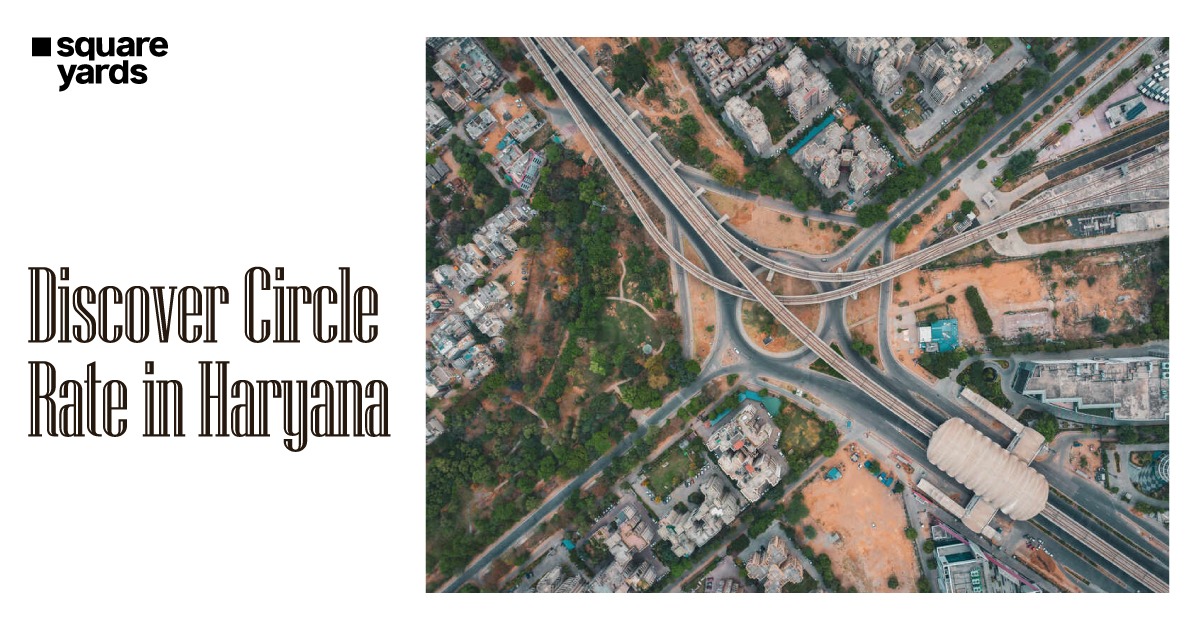The circle rate defines the minimum price for an asset enrolled in the state. Generally, the circle rate within the country varies based on the state and city. Regarding the city and state, the circle rate would vary based on the region. In addition, Circle rates aim to ensure accessibility, equality, and consistency in real estate transactions. They also manage the real estate market with greater proficiency. With the assistance of circle rates, authorities can govern the value of real estate. Likewise, The Haryana government has also imposed Circle Rates in Haryana to manage the cost of the property. The government makes adjustments yearly in a few sectors, particularly in business. The blog will delve into the circle rate in Haryana and the most recent price changes. However, you must first understand the distinction between a property's circular and market rates.
Table of contents
Haryana Circle Rates
Circle rates, also known as guideline prices or prepared reckoner rates, are the federal government's lowest rates for certain types of estates in a specific area. These rates are a benchmark for real estate operations, guaranteeing that assets are not overpriced during selling or purchasing. Circle rates in Haryana vary according to location, property type amenities, infrastructure, and regional demand-supply dynamics.
Importance of Circle Rates in Haryana
Some of the most important aspects of circle rate in Haryana to consider while buying a property are:
- Revenue: The circle rate is essential in tax calculation. The government frequently employs the minimum property value, based on circle rates, as a suitable calculating factor to determine the tax levied on an asset.
- Land Registration: Property registration and stamp duty computation are two of the most important aspects of property acquisitions. In Haryana, the government utilises the circle rate as one of the primary variables in computing stamp duty. Furthermore, it assists in determining the cost of real estate registration fees.
- Legal Disagreements: If there is a legal issue regarding real estate, the court will want to investigate the circle rates to address the problems.
How to Calculate Haryana Circle Rate?
To calculate the Haryana circle rate, multiply the construction area by the locality's circle rate. The circle rate varies by asset types, such as residential, agricultural land, and commercial buildings. Moreover, various factors influence Haryana's circular rates, including resource availability, marketplace value, and land type. In addition, developed locations with abundant resources often have higher circle rates, but commercial properties attract higher rates than residential homes.
Formula:
Value of the Property = Built-up area (sq. m) x circle rate for the locality (INR per sq. m)
Valuation Affecting Factors of Circle Rate in Haryana
Circle rates are determined through an elaborate method that considers various elements to arrive at a reliable and equitable property valuation. The government considers many crucial elements when setting or amending circle rates in Haryana, as in numerous other areas. Here's an in-depth look at the factors influencing circle rates:
- Property Location: This is likely the most critical factor impacting circle rates. Different regions of a city or district may have varying levels of growth, convenience, and appeal. Due to the rising demand for houses in good areas, such as those close to commercial places, residential areas, schools, banks, hospitals, or recreational hubs, circle rates tend to be higher.
- Property Type: Circle rates generally vary depending on the property type, whether residential or commercial. Residential circle rates in a specific region may differ from those for commercial businesses. Commercial locations, particularly those with strong customer traffic and potential for growth, usually have higher circle rates that indicate their financial significance.
- Amenities and Infrastructure: Circle rates are heavily influenced by the quality of nearby facilities and infrastructure. These are anticipated to be greater in highly developed locations with strong infrastructure, such as decent roads, transit, and other municipal amenities. Investors are frequently ready to pay higher prices for residences that offer comfort and ease.
- Real Estate Demand: Demand-supply fluctuations are crucial for influencing circle rates. Circle rates are expected to increase in locations where real estate is in strong demand. This is motivated by the simple economic concept of demand and supply: as demand grows, so does the value of homes in the region, prompting circle rates to change accordingly.
- Current Market Trend: Haryana circle rates are not fixed and are subject to periodic modifications based on market dynamics. Economic considerations, real estate shifts, and value changes influence the government's choice to adjust circular rates. Further, guarantees that prices remain appropriate for the current economic context.
- Growth Plans and Zoning Laws: Government proposals for building infrastructure, zoning laws, and urban design schemes all influence circle rates. Circle rates may rise in areas slated for future growth or with beneficial zoning restrictions that permit higher-density development to compensate for anticipated rises in real estate prices.
How to Check Haryana Circle Rate?
Follow the following steps to check the Haryana circle rate:
Step 1: Go to the official website of the Haryana district collector - revenueharyana[dot]gov[dot]in/draft-district-collector-rates/
Step 2: A new page on your screen containing a comprehensive list of all Districts.
Step 3: Click on the desired district to access more detailed information about a particular district.
Step 4: For future reference, you can download the PDF.
Haryana Circle Rate: City-Wise
The circle rates in Harayna vary according to the property type, land, demand, and other factors. The current circle rates in Haryana are shown below:
Gurgaon Circle Rate
The below table highlights the Gurgaon circle rates for 2024, based on sector and property type:
| Sector | Circle Rate (per sq ft) | Type of Property |
| Sector 63 | Rs 3,500 | Residential |
| Sector 62 | Rs 3,500 | Residential |
| Sector 61 | Rs 3,500 | Residential |
| Sector 60 | Rs 3,500 | Residential |
| Sector 59 | Rs 3,500 | Residential |
| Sector 58 | Rs 3,500 | Residential |
| Sector 57 | Rs 5,000 | Residential |
| Sector 56 | Rs 5,000 | Residential |
| Sector 55 | Rs 5,000 | Residential |
| Sector 54 | Rs 5,000 | Residential |
| Sector 53 | Rs 5,000 | Residential |
| Sector 52 | Rs 5,000 | Residential |
| Sector 51 | Rs 5,000 | Residential |
| Sector 50 | Rs 5,000 | Residential |
| Sector 46 | Rs 5,000 | Residential |
| Sector 43 | Rs 5,000 | Residential |
| Sector 41 | Rs 5,000 | Residential |
| Sector 40 | Rs 5,000 | Residential |
| Sector 31-32A | Rs 5,000 | Residential |
| Sector 30 | Rs 5,000 | Residential |
Circle Rates for Multi-Storey Apartments
| Locality | Circle Rate (per sq ft) |
| DLF Colony Old | Rs 6,000 |
| Housing Board Colony | Rs 3,800 |
| Sectors 104 to 115 | Rs 3,000 |
| Sectors 1, 2, 3, 3A, 4, 5, 6, 7, 12, 12A, 13, 14, 15, 16, 17, 21, 22, 22A, 23, 23A, 38, 40, 42, 43 | Rs 5,000 |
Faridabad Circle Rate
The table below shows the circle rates in Faridabad for 2024, categorised by sector and type of property:
| Sector | Price of Plot up to 500 sq. yards (per sq. m) | Price of Plot above 500 sq. yards (per sq. m) |
| Sector 14 | ₹53,820 | ₹47,840 |
| Sector 16 | ₹50,232 | ₹47,840 |
| Sector 17 | ₹50,232 | ₹41,860 |
| Sector 18 | ₹33,488 | ₹31,096 |
| Sector 18A | ₹33,488 | ₹31,096 |
| Sector 19 | ₹35,880 | ₹32,292 |
| Sector 21A | ₹41,860 | ₹38,272 |
| Sector 21B | ₹41,860 | ₹38,272 |
| Sector 28 | ₹41,860 | ₹35,880 |
| Sector 29 | ₹38,272 | ₹33,488 |
| Sector 30 | ₹38,272 | ₹33,488 |
| Sector 31 | ₹38,272 | ₹33,488 |
Circle Rates for Licensed Colonies
| Colony Name | Circle Rate (per sq. m) |
| Nehar Par Sector 79-83 | ₹47,840 |
| Nehar Par Sector 84-90 | ₹41,860 |
| Nehar Par Sector 97-98 | ₹35,880 |
| Ashoka Enclave | ₹41,860 |
| Spring Field Colony | ₹35,880 |
| Indraprastha Colony | ₹35,880 |
| Durga Colony | ₹29,900 |
source: faridabad.nic.in
Rewari Circle Rate
The table provides comprehensive and updated data on Rewari circle rates 2024 for better information for real estate transactions.
Sector-Wise Circle Rates
| Sector/Area | Circle Rate (per sq. meter) | Circle Rate (per sq. yard) |
| Bawal Block | ₹23,000 - ₹24,500 | ₹19,000 - ₹20,000 |
| Dharuhera | ₹27,500 - ₹29,000 | ₹22,000 - ₹23,000 |
| Kosli | ₹21,000 - ₹22,500 | ₹17,000 - ₹18,000 |
| Rewari Urban | ₹30,000 - ₹32,500 | ₹25,000 - ₹27,000 |
| Rewari Rural | ₹15,000 - ₹16,500 | ₹12,000 - ₹13,000 |
| Nahar Block | ₹19,000 - ₹20,500 | ₹15,500 - ₹17,000 |
| Khol Block | ₹20,000 - ₹21,500 | ₹16,000 - ₹17,500 |
| Jatusana Block | ₹18,000 - ₹19,500 | ₹14,500 - ₹16,000 |
Licensed Colonies Circle Rates
| Colony Name | Circle Rate (per sq. meter) |
| Sector 1, Rewari | ₹35,000 |
| Sector 2, Rewari | ₹33,000 |
| Sector 3, Rewari | ₹31,000 |
| Sector 4, Rewari | ₹29,000 |
| Dharuhera Industrial Area | ₹28,000 |
| Bawal Industrial Area | ₹26,000 |
Other Cities Circle Rate
| Circle Rate in Gurgaon | Gurgaon Circle Rate |
| Circle Rate in Faridabad | Faridabad Circle Rate |
| Circle Rate in Chandigarh | Chandigarh Circle Rate |
| Circle Rate in Delhi | Delhi Circle Rate |
| Circle Rate in Up | Up Circle Rate |
Haryana Circle Rate Latest News
The Haryana government has proposed a significant increase in circular rates, with some districts seeing 30-80% hikes. This proposal, originally scheduled to take effect on January 1, 2024, has now been pushed back to February 1, 2024. The public was encouraged to submit feedback until December 17, 2023. Areas, including Golf Course Road, MG Road, and Dwarka Expressway Highway, may experience up to 87% hikes. In addition, Faridabad, like Gurgaon, is projected to see a hike in circle rates. This change is part of a larger attempt to match circle rates with current market prices, resulting in more equitable revenue collection and decreased property undervaluation during sales.
Key Considerations When Calculating Haryana's Circle Rates in 2024
As you manage the complexities of circular rates in Haryana, keep these vital considerations in mind:
- Stay Updated: Circle rates can fluctuate and be impacted by government initiatives and market developments. As a result, it is critical to stay up to date on current rates.
- Evaluate All Costs: In addition to the circular rate, consider other expenses such as stamp duty, registration costs, and any extra fees which might affect your purchase.
- Consider Expert Guidance: The procedure can become complicated, particularly for big or distinctive properties. Dealing with a real estate professional may offer insight and guidance.
- Understanding the Impact: Circle rates immediately affect the property's registration worth, affecting both the buyer's and seller's monetary obligations.
FAQ's about Circle Rates in Haryana
To find the circle rate of property in Haryana, refer to the Haryana district's official website.
As per a recent report, the Haryana government has observed a 30% to 80% rise in circle prices in Gurgaon.




